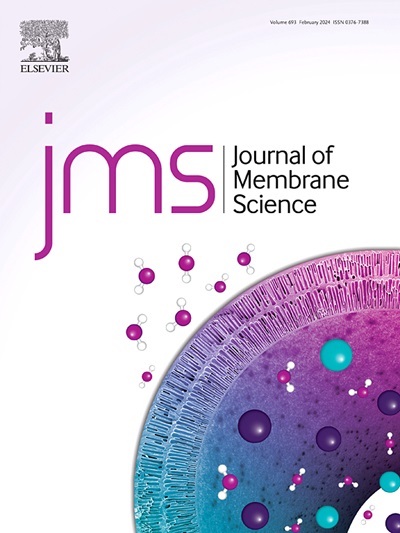分子杂交增强聚酰胺纳滤膜用于抗生素脱盐
IF 8.4
1区 工程技术
Q1 ENGINEERING, CHEMICAL
引用次数: 0
摘要
抗生素脱盐是分离纯化目标化合物,保证其稳定性和治疗效果的关键过程。然而,传统纳滤膜的效率和可扩展性往往受到渗透性和选择性之间权衡的限制。本研究采用分子杂交策略,将1,4,7,10四氮杂环十二烷(Cyclen)与哌嗪(PIP)结合,与三甲基氯(TMC)反应。这种方法旨在创造更松散的聚酰胺结构,并提高抗生素脱盐的性能。结果表明,改性膜的透水性为25.2 L m−2 h−1 bar−1,几乎是对照膜(12.2 L m−2 h−1 bar−1)的两倍。此外,改性膜的NaCl/四环素选择性为58.8,并且在连续浓度实验中表现优异,四环素浓度增加了4.65倍,显著超过对照膜(1.43倍)。所提出的改性策略显示了提高纳滤膜在抗生素脱盐中的性能的巨大潜力,为克服现有限制和提高工业实施的可扩展性提供了可行途径。本文章由计算机程序翻译,如有差异,请以英文原文为准。
Molecular hybridization enhanced polyamide nanofiltration membranes for antibiotic desalination
Antibiotic desalination is a critical process for isolating and purifying target compounds, ensuring their stability and therapeutic efficacy. However, the efficiency and scalability of conventional nanofiltration membranes are often limited by the trade-off between permeability and selectivity. In this study, a molecular hybridization strategy is employed, combining 1,4,7,10 tetraazacyclododecane (Cyclen) with piperazine (PIP) to react with trimesoyl chloride (TMC). This approach aims to create a looser polyamide structure and enhance performances in antibiotic desalination. The results demonstrate that the modified membranes achieve a water permeance of 25.2 L m−2 h−1 bar−1, nearly twice that of the control membrane (12.2 L m−2 h−1 bar−1). Additionally, the modified membranes exhibit a NaCl/tetracycline selectivity of 58.8, along with exceptional performance in consecutive concentration experiments, where tetracycline concentration increases by 4.65-fold, significantly exceeding that of the control membrane (by 1.43-fold). The proposed modification strategy demonstrates significant potential for advancing nanofiltration membrane performance in antibiotic desalination, offering a viable pathway to overcome existing limitations and enhancing scalability for industrial implementation.
求助全文
通过发布文献求助,成功后即可免费获取论文全文。
去求助
来源期刊

Journal of Membrane Science
工程技术-高分子科学
CiteScore
17.10
自引率
17.90%
发文量
1031
审稿时长
2.5 months
期刊介绍:
The Journal of Membrane Science is a publication that focuses on membrane systems and is aimed at academic and industrial chemists, chemical engineers, materials scientists, and membranologists. It publishes original research and reviews on various aspects of membrane transport, membrane formation/structure, fouling, module/process design, and processes/applications. The journal primarily focuses on the structure, function, and performance of non-biological membranes but also includes papers that relate to biological membranes. The Journal of Membrane Science publishes Full Text Papers, State-of-the-Art Reviews, Letters to the Editor, and Perspectives.
 求助内容:
求助内容: 应助结果提醒方式:
应助结果提醒方式:


